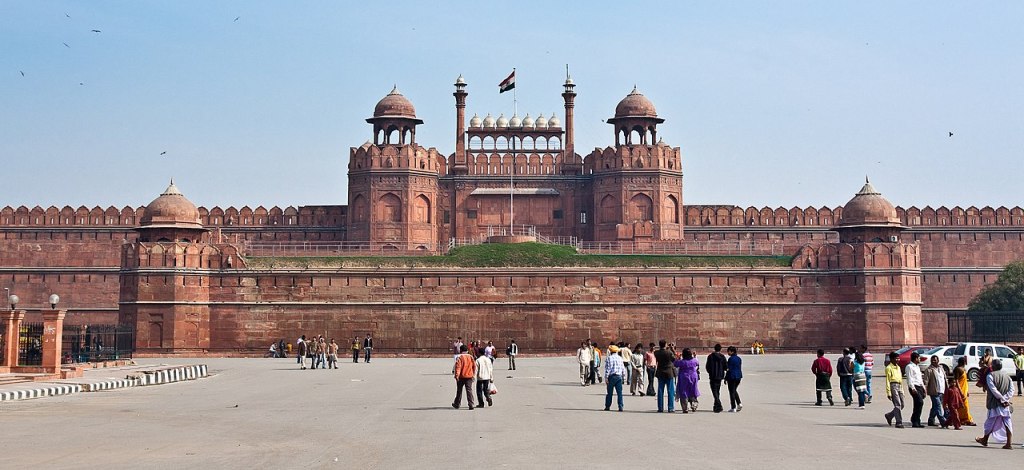Making a Tryst with Delhi: Let’s Take a Look at the City’s Major Heritage Sites

Datanews India
New Delhi, January 18, 2024: Does Mughal history fascinate you? Do you relish street food? Do you like to move slowly, viewing the ancient old buildings sitting on a cycle rickshaw navigating through the crowded bazaars?
You can have all these questions answered if you come to Delhi’s ancient market place Chandni Chowk designed by Jahanara Begum, the daughter of Emperor Shah Jahan.
As old Sultan Mian peddled his rickshaw en route Jama Masjid through Dariba Kalan, one of the earliest streets of Delhi, I just could not resist the temptation of trying Aloo Paratha with Chhole.
Which place for this dish could be better than Gali Paratha Wali of Chandni Chowk? Can you imagine, this Kucha (Gali or narrow lane) was created way back in 1650? I ordered two plates of Paratha: one of me, another for Sultan.

After relishing Paratha, I headed towards Jama Masjid. In fact, a heritage walk of Delhi would not carry much meaning unless you visit this ancient mosque. It was quite crowded with a large number of foreign tourists thronging there.
I relieved Sultan of his task of carrying me as my next destination Jama Masjid lay within walking distance.
Jama Masjid
Built in 1650 by a Royal Firman (order) of Shah Jahan, Jama Masjid came up a time when Delhi was known as Shahjehanabad.

Since Syed Abdul Ghafoor Shah Bukhari inaugurated it as the mosque’s first Imam, it had been in use for regular prayers which are held even today in the same way as it used to be 373 years ago.
Jama Masjid’s architectural design was done by Ustad Khalil. A very interesting fact about the mosque’s construction is that among the 5000 masons who worked day and night under the direct supervision of Wazir Sadullah Khan, some were Europeans also. The others were mostly Indians, Arabians, Persians, Turks,.
Lal Qila
Majestic Lal Qila, the Red Fort, is an integral part of the heritage sites that lie strewn in Delhi. This UNESCO listed site is an architectural wonder besides being a living page of the history of Delhi from the days of Shah Jehan till the last Mughal Emperor Bahadur Shah Zafar.

Many people don’t know that this red sandstone 75 feet high fort is the second Red Fort of India as the first Red Fort was built near the Qutub Minar way back in the 11th century by Anangapala, a mighty Tomara king.
If you are really interested to know the past of Delhi, you should wait inside Lal Qila till evening for the Sound and Light Programme. Timings of this programme vary according to the seasons. The timing details are given below:
September to October: 8.30 pm to 9.30 pm (English), 7 pm to 8 pm (Hindi)
November to January: 7.30 pm to 8.30 pm (English), 6 pm to 7 pm (Hindi)
February to April: 8.30 pm to 9.30 pm (English), 7 pm to 8 pm (Hindi)
May to August: 9 pm to 10 pm (English), 7.30 pm to 8.30 pm (Hindi)
Important Note: Mondays are closed.
Jantar Mantar
From Lal Qila, one can take an auto rickshaw to go to Connaught Place within 15 minutes if you don’t have road traffics. Named after Prince Arthur, 1st Duke of Connaught and Strathearn, this ancient business district took nearly four years to be completed after its works started in 1929.
From Connaught Place, it takes only a few minutes to reach Jantar Mantar.
Near the busy Connaught Place, there lies Jantar Mantar, an ancient observatory created by Maharaja Jai Singh-II of Jaipur in 1724. Standing 723 feet in height, Jantar Mantar was used in those olden days to measure the celestial bodies.

Maharaja Jai Singh took keen interest in astronomy besides the other subjects. There hardly was any king in those days who had acquired such profound knowledge in astronomy like him. After its construction, Jantar Mantar acted as Delhi’s only observatory predicting times and movements of sun, planet and other celestial bodies.
Though Jantar Mantar was damaged during the Sepoy Mutiny of 1857, yet the Ram Yantra, the Samrat Yantra, the Jai Prakash Yantra and the Misra Yantra still lie with all its past glories.
After visiting it, I crossed the road to reach Rajiv Gandhi Chowk Metro Railway Station to catch a train straight for Mehrauli where Qutub Minar stands.
Qutub Minar
No heritage walk of Delhi is possible without a sight of Qutub Minar which now stands at Lal Kot area where once the Rajput of Tomar dynasty ruled.
This UNESCO World Heritage Site was constructed between 1199 and 1220 by Gutub-Uddin-Aibak, the first ruler of Delhi Sultanate. This unique victory tower is famous for its rectangular courtyard enclosed by cloisters and erected with the carved columns.
One of the most notable things to view is the rust-proof Iron Pillar with Sanskrit inscription written in Brahmi script. It belonged to the 4th century A.D. and was erected by King Chandra as Vishnudhvaja: the standard of Lord Vishnu.
It is really a wonder that this iron pillar dis not decay through oxidation or gather rust even after about 1600 years proving the most perfect metallurgical research carried out in those days of the past in India.
In Conclusion
Now it is time for me to return to my hotel located near the New Delhi Railway Station. Reaching there is quite easy and also comfortable as you can catch the metro rail to reach your hotel within a matter of just about 50 minutes.
As I complete my heritage walk in and around Delhi, I salute the ancient masons and architects who constructed one after another wonder in India’s capital. Each of these creations rivals the other.





